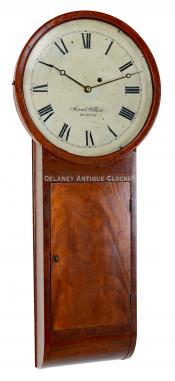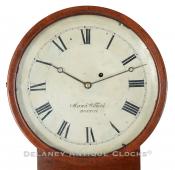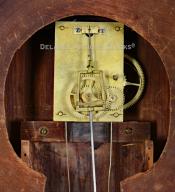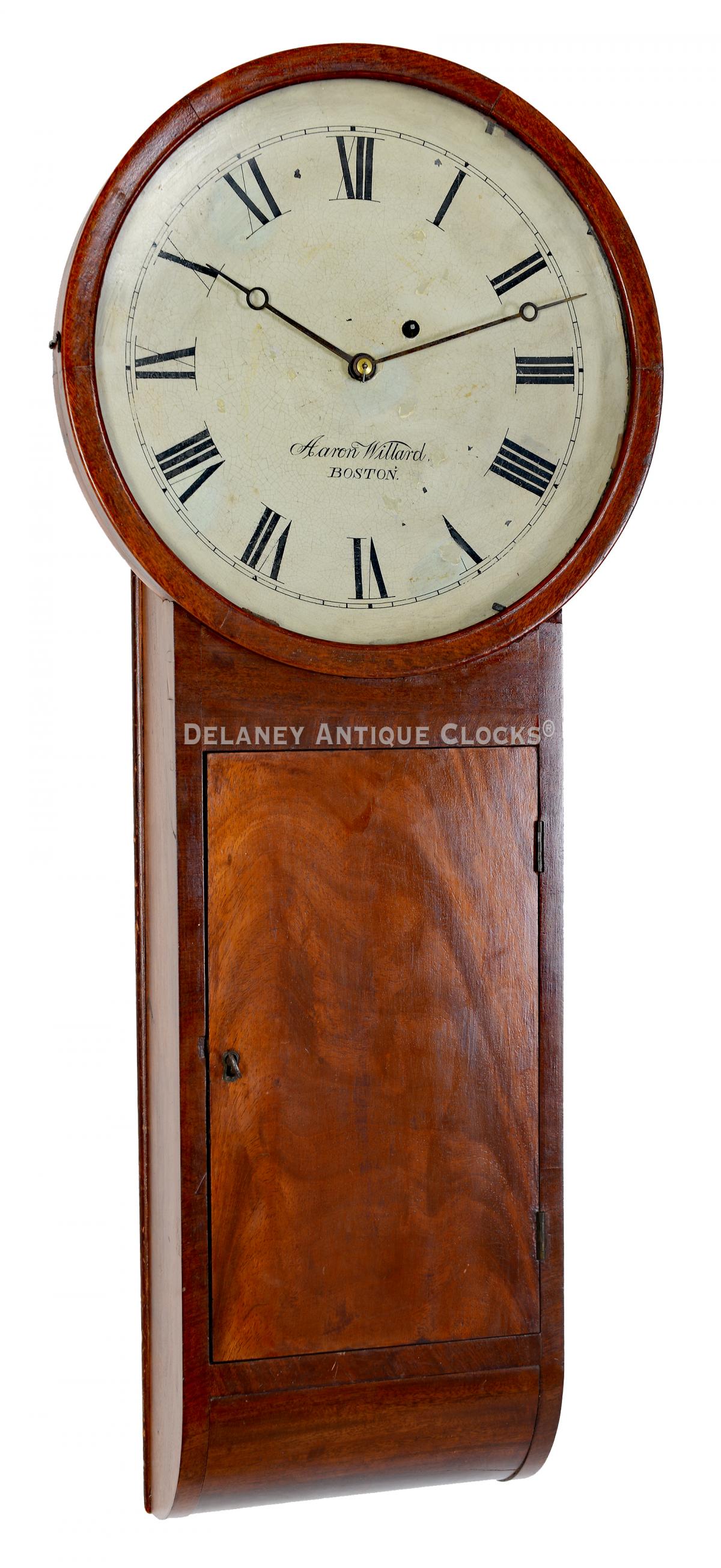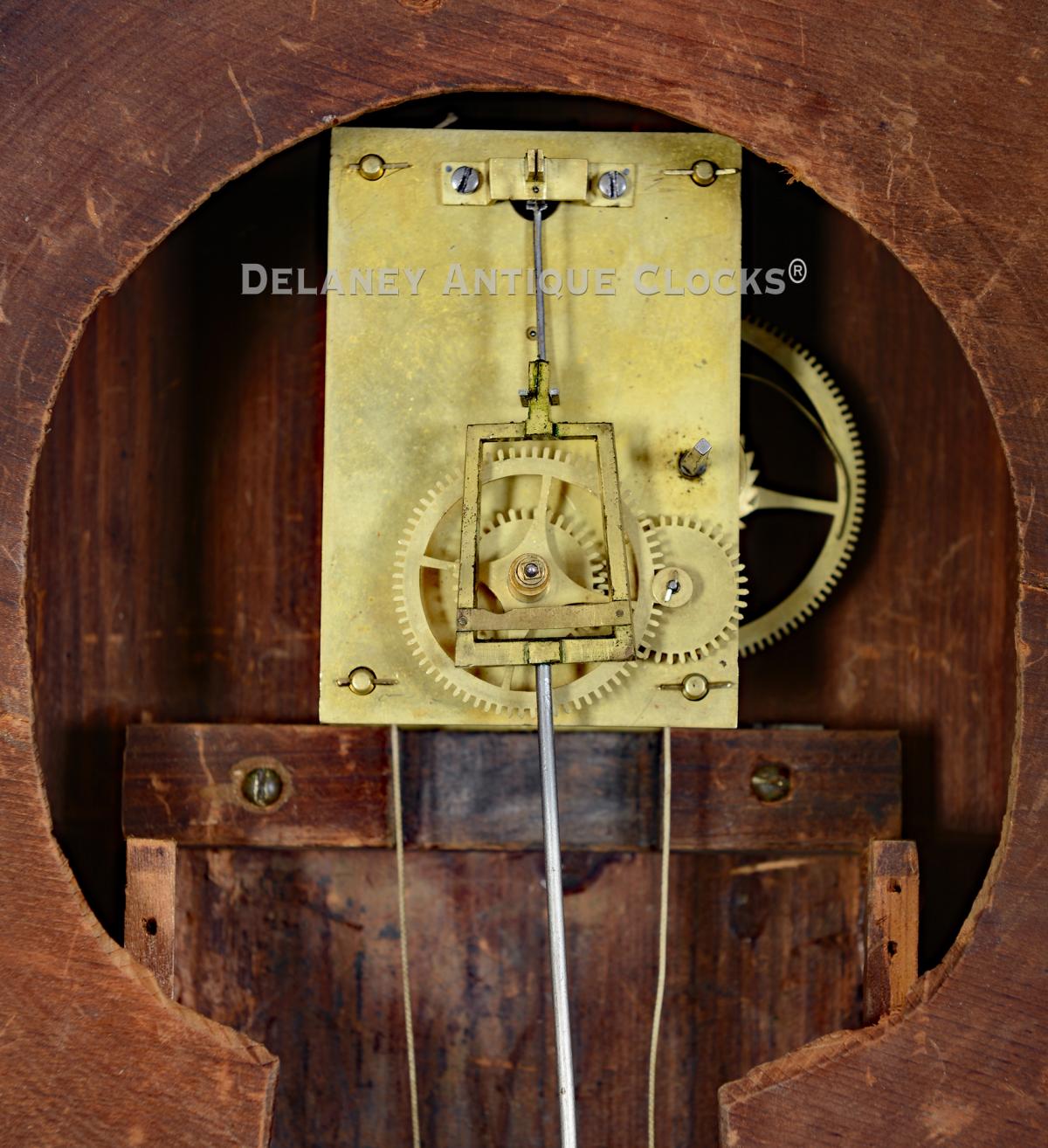Aaron Willard Tavern Clock. Boston, Massachusetts. DDD-43.
Aaron Willard made this wall beautiful wall tavern clock. Its original use may have been in a commercial application of some kind. The cabinet's simple design is robust and lacks the inclusion of fragile reverse-painted glasses. Colorful glasses were part of the design and decoration of most banjo clocks of the day. This form is simple and practical. The case is compact, measuring 30.5 inches long. The oversized head supports a large dial, making it easy to read from across the room. The drop section protects the weight and pendulum. It is long enough for the weight to travel eight days and wide enough for the pendulum to swing without interference. The other known examples were signed by Abel Stowell & Son, who worked in Charlestown, MA, and J. N. Dunning of Burlington, Vermont.
I can easily argue that this form did not survive well. Commercial appliances often lack a personal connection to the original purchaser. This is because commercial clocks are owned by the businesses they serve and are taken care of by employees. This clock form was one of the first in this country to be marketed for public use. The marketing of clocks for public services was a sales model that would greatly expand over the next 100 years.
Interestingly, other clock companies extensively copied and slightly modified this practical form over the years. First, the Terry's of Connecticut made a similar style, and then E. Howard, Seth Thomas, Boston Clock, etc., all offered clocks made in a similar form, which were successfully sold.
This case is constructed of mahogany and white pine from New England. The mahogany features an older, possibly original, finish that glows against the wall. Distinct features of this early form include a quarter-round shape at the base of the case. This gracefully rolls back against the wall. The access door above features a choice crotch pattern of mahogany. The cabinetmaker chose this veneered panel for its appealing grain pattern. This door provides access to the brass-faced pendulum bob, rating nut, and the drive weight. The circular wooden bezel is nicely formed and is fitted with glass. It opens to a 12-inch circular dial.
The clock's focal point is the 12-inch convex-painted iron dial. The convex shape of the iron was meticulously hammered into form, providing ample space for the clock's open-moon hands to move freely. Roman-style hour numerals are positioned within a segmented minute track. "Aaron Willard / BOSTON" is proudly signed on the dial.
Behind the dial is the eight-day brass movement. A single screw mounts the works to the back of the case. A wooden weight stop ensures additional support and serves as a contact point for the weight, contributing to the clock's stability and longevity. The rectangular brass plates frame the steel pinions and brass gearing. A bridge that supports the pendulum is mounted at the top of the front plate. The works are driven by a lead-weight die-stamped "J. Stone." Jasper Stone is recorded in Paul Foley's book Willard's Patent Timepieces. He worked as a clockmaker, watchmaker, and jeweler in Charlestown from 1838 to 1892.
We have seen very few similar clocks over the years that dated from this 1830 period.
Inventory number DDD-43.
Aaron Willard was born in Grafton, Massachusetts, on October 13, 1757. Little is currently known of Aaron's early life in Grafton. His parents, Benjamin Willard (1716-1775) and Sarah (Brooks) Willard (1717-1775) of Grafton had eleven children. Aaron was one of four brothers that trained as a clockmaker. In Grafton, he first learned the skills of clock-making from his older brothers Benjamin and Simon. It is recorded that Aaron marched with them in response to the Lexington Alarm on April 19, 1775, as a private under Captain Aaron Kimball's Company of Colonel Artemus Ward's Regiment. Aaron re-enlisted on April 26 and was soon sent by General George Washington as a spy to Nova Scotia in November. By this time, he had reached the grade of Captain. He soon returned to Grafton to train as a clockmaker. In 1780, Aaron moved from Grafton to Washington Street in Roxbury along with his brother Simon. Here the two Willards establish a reputation for themselves as fine clock manufacturers. They were both responsible for training a large number of apprentices. Many of these became famous clockmakers in their own right. The Willards dominated the clock-making industry in the Boston area during the first half of the nineteenth century. Aaron worked in a separate location in Roxbury from his brother and, in 1792, relocated about a quarter-mile away from Simon's shop across the Boston line. Aaron is listed in the 1798 Boston directory as a clockmaker "on the Neck," His large shop employed up to 30 people, while 21 other clockmakers, cabinetmakers, dial and ornamental painters, and gilders worked within a quarter-mile radius by 1807.
Some important dates for Aaron Willard include...
1783, Aaron married Catherine Gates. They have two children. The first is Aaron Willard Jr who becomes a very accomplished clockmaker. Catherine Gates dies in 1785.
1789, Aaron marries Polly Patridge. Polly has two sisters that also marry clockmakers Abel Hutchins and Elnathan Taber. Aaron and Polly have nine children. Two work-in-the-clock trades. George Willard 1817-1821 becomes a journeyman clockmaker. Henry Willard (1822-1887) trained as a cabinetmaker and made cases for the Willard operation when he came of age.
1792, Aaron builds a large home at 143 Washington Street in Boston. He lives in this house until he dies. This house is also the location of his workshop. A barn is converted into an area to finish wood. Other spaces in the carriage shop are rented to related artisans.
1802-1804, Aaron is in a business partnership with cabinetmaker James Blake as Willard & Blake. Aaron's position is financial.
1804, Aaron he transforms the carriage house and barn into a workshop space for artists, clockmakers, woodworkers, etc. It is now known as Willard's Compound.
1805-1806, Aaron is a financial backer in the partnership of Willard & Nolen. Spencer Nolen (1784-1849) is an ornamental artist who begins painting clock dials. In 1808, Spencer Nolen married Aaron Willard's daughter.
1823, Aaron Willard retires. He is 66 years old.
1844, Aaron died on May 20 and is buried in the Eustis Cemetery in Roxbury.
We have owned a large number of tall case clocks made by this important Maker. In addition, we have also owned a good number of wall timepieces, some in the form of banjo clocks, gallery clocks, as well as numerous Massachusetts shelf clock forms.


